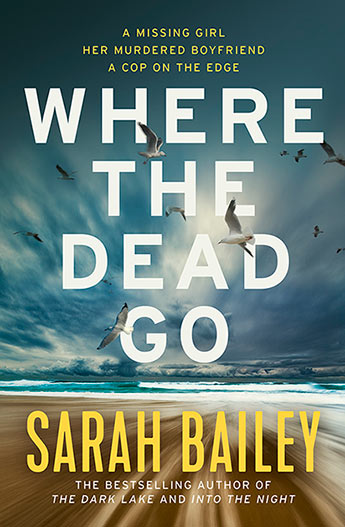Author: Sarah Bailey
Publisher/Year: Allen & Unwin/2019
Publisher Overview
A fifteen-year-old girl has gone missing after a party in the middle of the night. The following morning her boyfriend is found brutally murdered in his home. Was the girl responsible for the murder, or is she also a victim of the killer? But who would want two teenagers dead?
The aftermath of a personal tragedy finds police detective Gemma Woodstock in the coastal town of Fairhaven with her son Ben in tow. She has begged to be part of a murder investigation so she can bury herself in work rather than taking the time to grieve and figure out how to handle the next stage of her life – she now has serious family responsibilities she can no longer avoid. But Gemma also has ghosts she must lay to rest.
Gemma searches for answers, while navigating her son’s grief and trying to overcome the hostility of her new colleagues. As the mystery deepens and old tensions and secrets come to light, Gemma is increasingly haunted by a similar missing persons case she worked on not long before. A case that ended in tragedy and made her question her instincts as a cop. Can she trust herself again?
Reviewer: Susan Francis
Where the Dead Go is Bailey’s third novel in her police procedural series, following the complex and feisty character, Sydney Detective, Gemma Woodstock. In this book, the setting changes to the isolated coastal town of Fairhaven, north of Byron Bay where Gemma has been asked to fill in for the town’s long-standing Inspector and investigate a homicide and a missing person’s case.
I have to say I adored this book. Mainly because of the central character Gemma Woodstock. From the very beginning her life is complicated by a funeral and the desperate need to escape the ensuing confusion this produces. But travelling to Fairhaven and attempting to mask her grief with work is complicated by the necessity of having to take her young son into an unfamiliar and possibly dangerous environment and the cries of protest from everyone around her who disagrees with her decision. Her partner Mac is equally unimpressed. Unsurprisingly, Gemma ignores all and sundry and ends up in the dubious small town of Fairhaven where even her colleagues don’t appear quite trustworthy.
Bailey skilfully builds the main plot reflecting her character arc. Can the missing girl be found? If she is still alive, does she even want to be found? And will Gemma ever resolve the competing calls on her heart? As the professional and emotional drama unfolds for Gemma, the reader rushes onto Gemma’s side because what she wants is what we all want. What any modern working woman wants: to be able to do her job in a professional manner but still be able to devote time and love to her children and her partner. So, the duality of the competition between what will receive priority in Gemma’s life, the professional or the personal, echoes the duality of the crime – both reminiscent of a case Gemma recently worked and mirroring an earlier crime in the town itself.
But Gemma is central to the book and the plot is weaved around her complicated inner life, narrated smoothly from a first-person perspective. She is so likeable as a character. And despite her uncertainties about herself, and all the walls she erects, in the role of crime solver she is utterly reliable and the reader is left in no doubt about her ability and her resolve.
Tension is built slowly but consistently across a wide-ranging backdrop, and this is perhaps what I admire most about Bailey’s writing. For in spite of the story beginning in the middle of drama, the book never let me go, slowly, slowly ratcheting up the pressure but never ever giving anything away. It was a genuine page turner.
Bailey possesses an extensive knowledge of police procedure. She creates some first-class dialogue establishing how an investigation is undertaken and the authenticity she employs is fantastic. “Locating the weapon is priority number one, but I want the house, garage and yard swept for any traces of drugs,” I say as we gather in the shade of the carport. “And we need all electronic devices bagged and sent to the lab as soon as possible. I also want the photos in the bedroom dusted for prints…”. Bailey’s confidence and skill in recreating police procedure, grounds the book in a very solid and believable way.
Finally, I was legitimately surprised by the ending. No one played the part in the crime that I had guessed they had, but on reflection, Bailey plants appropriate if subtle clues. The plot is nicely complicated, not beyond comprehension, and I believe that, combined with the solid procedural detail, and such a flawed and sympathetic character makes this story, for me, a reason to make a quick visit to the bookshop and stock up on the first two Gemma Woodstock novels.
So pleased to have the opportunity to review this book and discover a new, Australian woman crime writer to fangirl over.
